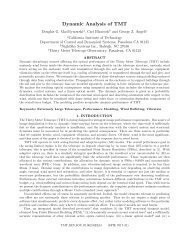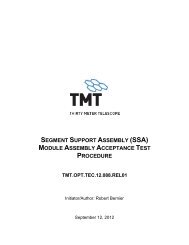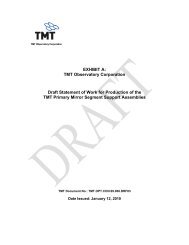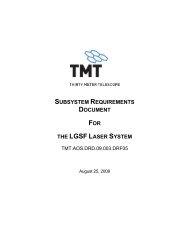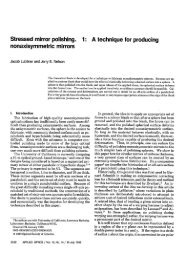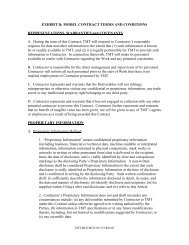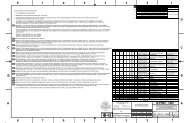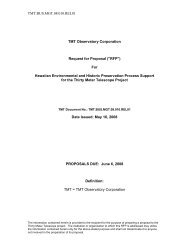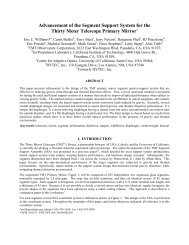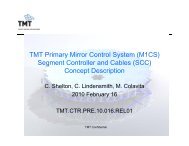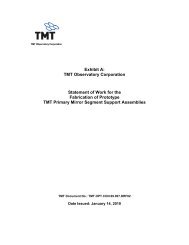An Edge Sensor Design for the TMT - Thirty Meter Telescope
An Edge Sensor Design for the TMT - Thirty Meter Telescope
An Edge Sensor Design for the TMT - Thirty Meter Telescope
Create successful ePaper yourself
Turn your PDF publications into a flip-book with our unique Google optimized e-Paper software.
<strong>TMT</strong>.CTR.JOU.06.002.REL01<br />
The alignment/phasing processes tune ∆V (= V offset<br />
) to achieve ∆V/V + ∆B/B + (B+f) ∆ω/2G) = 0<br />
Afterwards <strong>the</strong> segment stabilization system uses <strong>the</strong> reading change δR to move <strong>the</strong> segments to correct small non-zero<br />
values δz and δω.<br />
δR = [2εV/G] [ δz +(B(B+f)/(2G)) δω ]<br />
Define L effective<br />
= B(B+f)/(2G) ⇒ δR = [2εV/G] (δz + L effective<br />
δω)<br />
Sensitivity to δθ z<br />
A rotation about <strong>the</strong> z axis to first order will not change <strong>the</strong> average gap and will have no effect on <strong>the</strong> final charge<br />
developed on <strong>the</strong> sense plate. The next order effect is negligibly small (δC/C ~ 0.2 x 10 −10 ).<br />
Sensitivity to δθ y<br />
Consider <strong>the</strong> segment rotated about y, such that <strong>the</strong> o<strong>the</strong>r sensor on <strong>the</strong> same segment edge reads a maximum of it’s<br />
operating range. A calculation <strong>for</strong> our proposed sensor shows <strong>the</strong> false reading generated by this rotation is ~10 −14 m,<br />
negligibly small.<br />
Sensitivity to δx<br />
The drive plates are intentionally wider than <strong>the</strong> sense plate in order to make <strong>the</strong> output insensitive to small δx. Second<br />
order fringe-field effects are expected to cancel and only negligibly small third order fringe-field effects will contribute.<br />
A potentially significant δx sensitivity is created if a fabrication/installation error introduces a difference in θ y<br />
between<br />
<strong>the</strong> sense plate and <strong>the</strong> drive plates, θ y-d-s<br />
. Then a gravity-induced or temperature-induced change in x (δx) causes a<br />
reading change corresponding to δz false<br />
= δx θ y-d-s<br />
. Assume <strong>the</strong> sense plate has width = 30 m and is applied to an<br />
accuracy of 10 microns rms at <strong>the</strong> corners with respect to <strong>the</strong> block <strong>the</strong>n θ y-d-s<br />
= 0.010/15 = 7 x 10 −4 radians rms. If<br />
δx = 0.1 mm. ⇒ δz false<br />
= 70 nm rms. This is a large effect, and will be removed using a fit to all gap measurements to<br />
establish <strong>the</strong> value of δx to < 5 microns and a fit to temperature and zenith angle to refine this to δx to < 1 micron,<br />
resulting in δz false<br />
< 0.7 nm rms.<br />
Sensitivity to δy (= gap change = δG)<br />
Since <strong>the</strong> gap (G) will vary with gravity and temperature (resulting in changing <strong>the</strong> sensor output), we also need to<br />
measure G. We address below 1) <strong>the</strong> sensitivity to gap changes, 2) <strong>the</strong> expected size of <strong>the</strong> changes, 3) a method to<br />
measure <strong>the</strong> gap, and 4) <strong>the</strong> processing of <strong>the</strong> measurements. The gap measurement will be used to digitally correct <strong>the</strong><br />
reading δR.<br />
1) Sensitivity to gap changes. There are three ways a change in <strong>the</strong> gap (δG) affects <strong>the</strong> reading δR.<br />
• It changes <strong>the</strong> sensitivity to δz. δR/δz = 2εaV/G δ(δR/δz) = (δR/δz)(−δG/G)<br />
• It changes <strong>the</strong> sensitivity to δω δR/δω = 2εaVB(B+f)/(2G 2 ) δ(δR/δω) = (δR/δω)(−2δ/G)<br />
• It means <strong>the</strong> offset voltage is erroneous<br />
V offset<br />
= −V[∆B/B + (B+f)∆ω/(2G)] δV offset<br />
= −V(B+f)∆ω δG/(2G 2 )<br />
δR = 2εBδV offset<br />
/G = −2εVB(B+f)∆ω δG/(2G 3 )<br />
where ∆ω is <strong>the</strong> dihedral angle between segments after segment installation.<br />
In terms of a comparable δz δz = −B(B+f)∆ω δG/(2G 2 )<br />
2) Expected size of gap changes.<br />
Temperature-induced: If <strong>the</strong> cell temperature changes by 10 o C, <strong>the</strong>n δG = 125 microns.<br />
If we assume a rate of 1 o C per hour, <strong>the</strong>n δG/dt = 3.5 nm/second.



